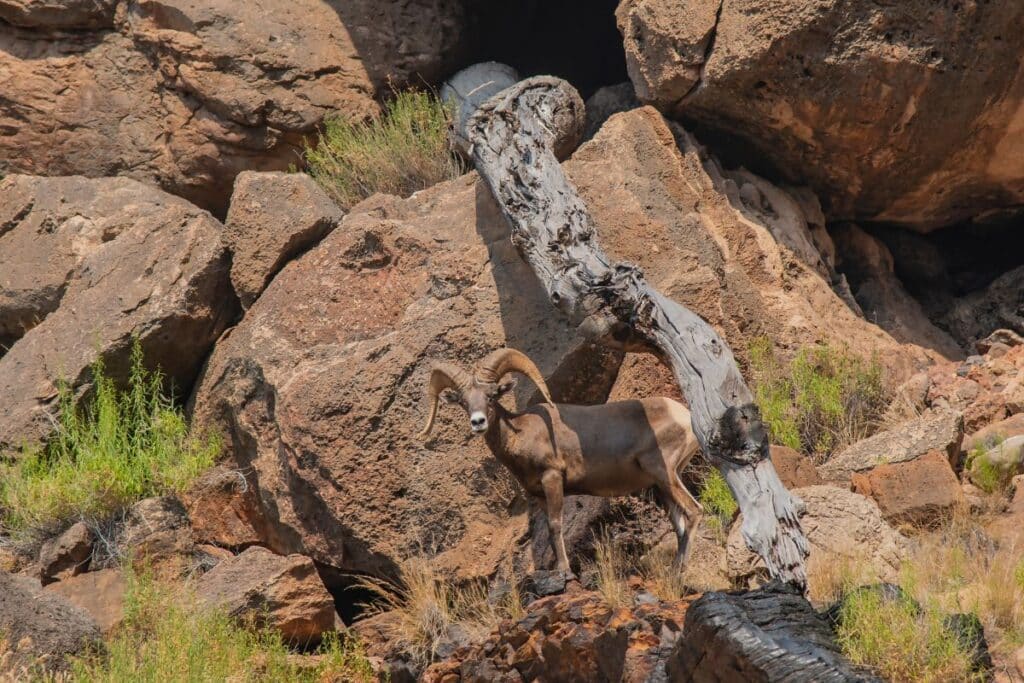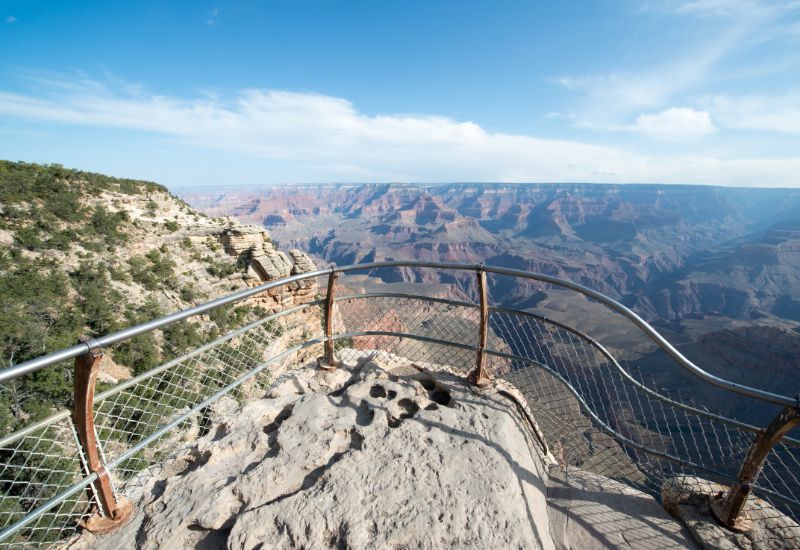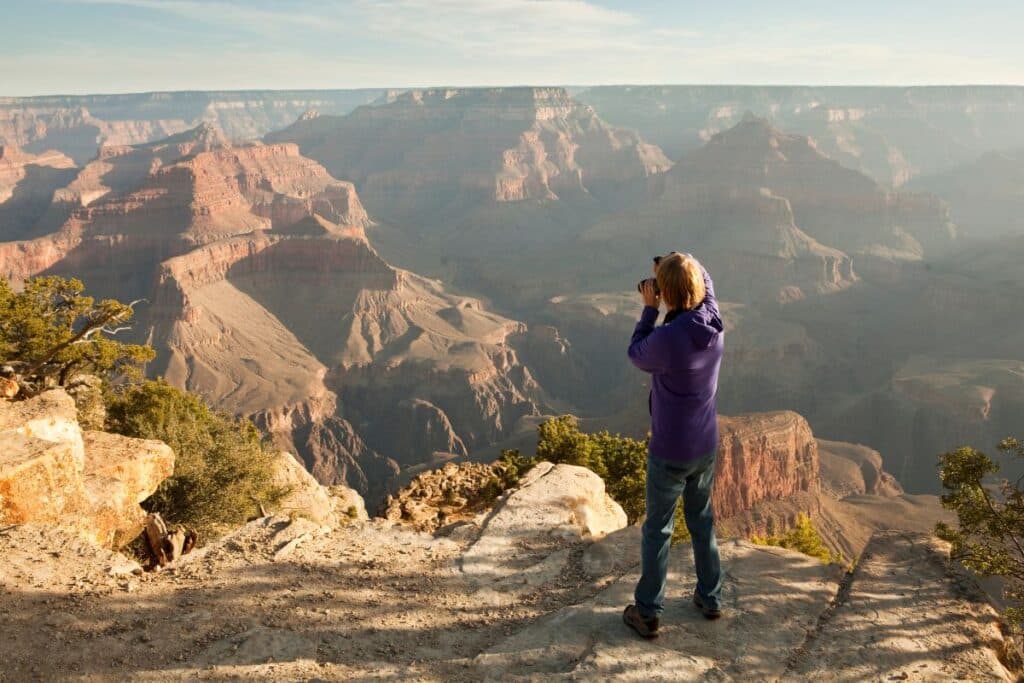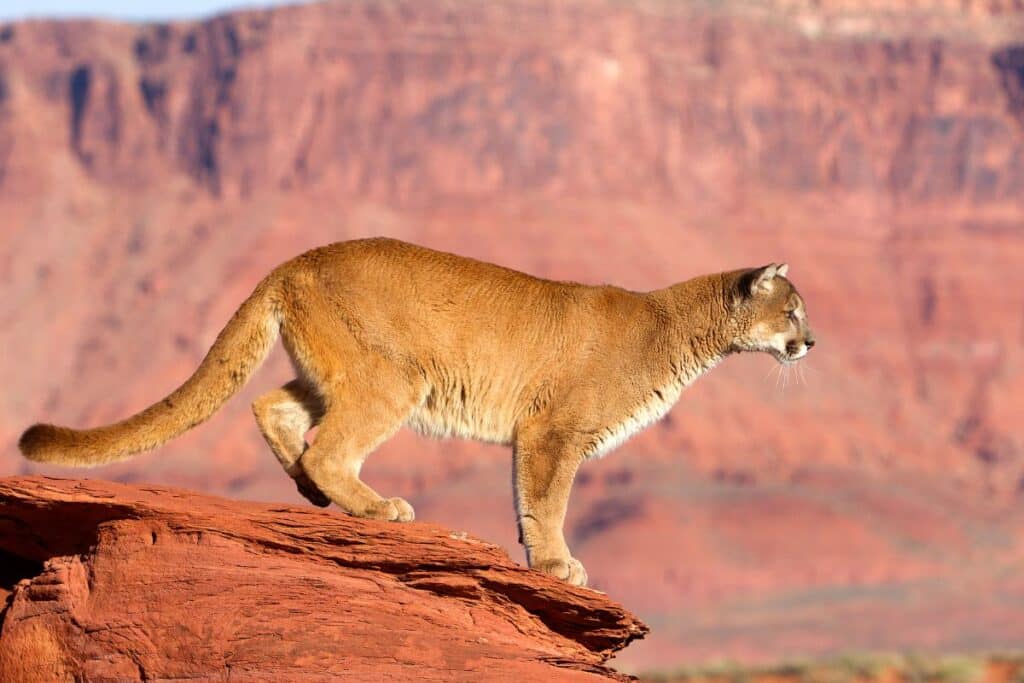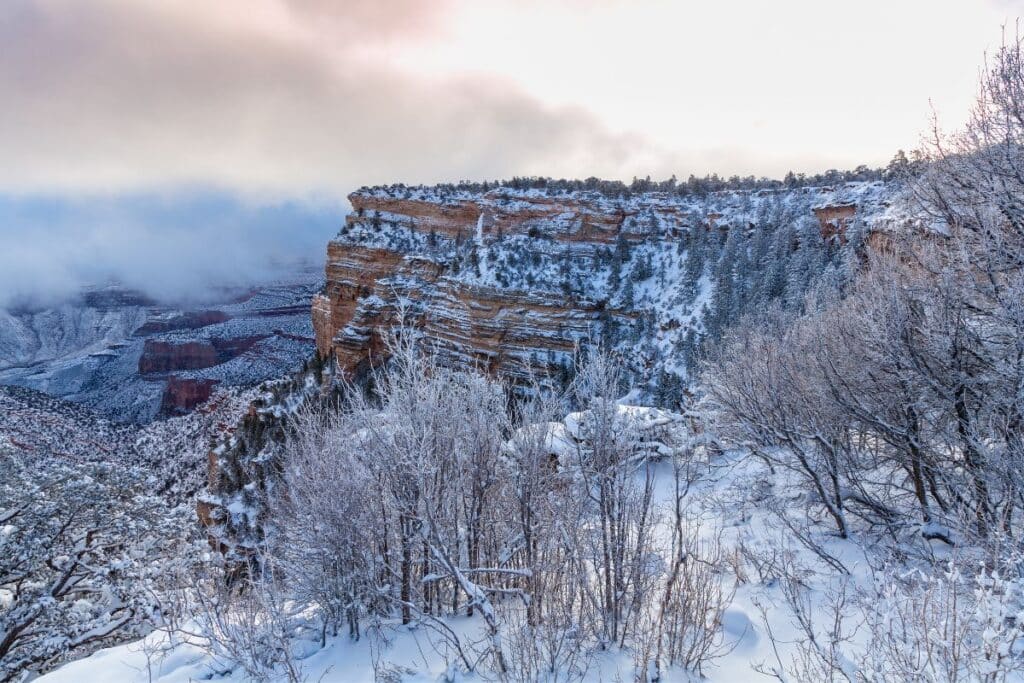Bighorn sheep gracefully navigating steep cliffs, mountain lions prowling the rim, and California condors gliding majestically overhead – welcome to the animal kingdom of the Grand Canyon National Park.
This is your ultimate guide to wildlife viewing in the spectacular Grand Canyon National Park.
Packed with expert tips, we’ll show you how to spot these magnificent creatures and share the best times and places to see them in their natural habitat. Get ready for an exciting journey into the wild side of one of America’s greatest natural treasures.
Bighorn Sheep
Bighorn Sheep, iconic for their large curled horns, are a majestic sight in the Grand Canyon. They are often seen gracefully navigating the steep cliffs and slopes. Key areas for spotting these agile animals include the Bright Angel Trail and the South Rim.
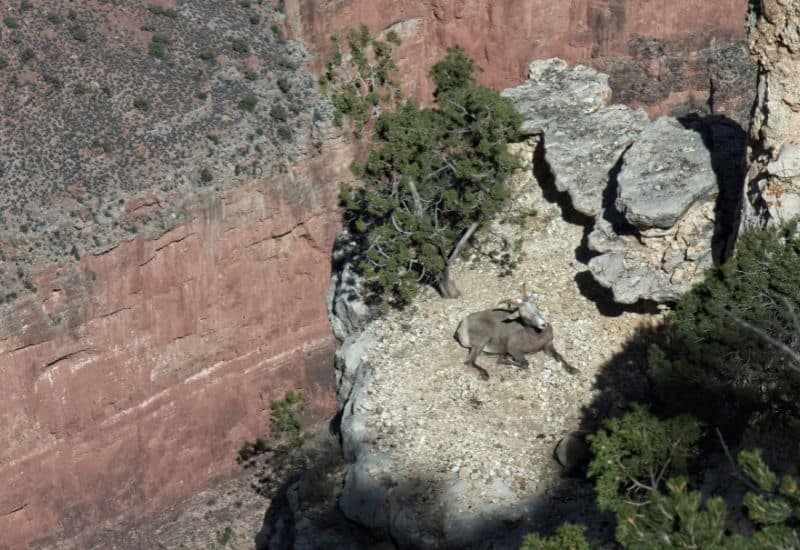
These animals are celebrated for their surefootedness, effortlessly traversing rugged terrains. Early mornings or late afternoons along the North Kaibab Trail are ideal times for sightings.
The presence of the Bighorn Sheep highlights the Grand Canyon’s rich biodiversity. They are often visible along the Tonto Trail, showcasing the area’s natural ecosystem.
Their seasonal movements make them more visible at lower elevations during cooler months, especially near the Hermit Trail and Phantom Ranch.
Remember, while observing these magnificent creatures, it’s crucial to respect their space and view them from a distance, ensuring their continued thriving in this spectacular natural setting.
Common Ravens
Common Ravens are a ubiquitous presence in the Grand Canyon, easily recognized by their distinctive croaking sounds. These intelligent birds are often seen scavenging for food, adding a unique character to the canyon’s soundscape. While hiking, look up to see them soar or perch atop the canyon’s formations.
Common Ravens are adaptable and can be spotted across various regions of the park. Key areas to observe these birds include the South Kaibab Trail and the open spaces near Mather Point, where they’re often seen gliding on air currents or exploring the ground.
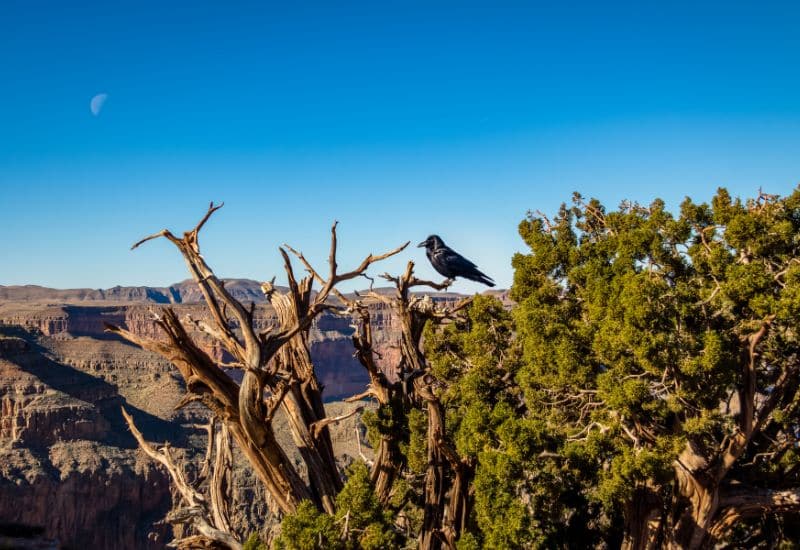
Their black plumage and large size make them easy to spot against the backdrop of the canyon’s colorful landscape. Hikers along the Bright Angel Trail and in the North Rim areas are likely to witness these birds engaging in their playful flying antics or foraging activities.
The Common Raven’s presence in the Grand Canyon is not just about their scavenging habits; they are an integral part of the ecosystem, playing a role in cleaning up and maintaining the natural balance. Observing them offers an insight into the complex interplay of life in this diverse habitat.
As with all wildlife in the Grand Canyon, it’s important to observe the Common Ravens from a distance and not disturb them, especially while they are feeding. This ensures a respectful coexistence and allows for continued enjoyment of these fascinating birds by future visitors.
Coyotes
Coyotes in the Grand Canyon are a testament to the adaptability and cunning of nature. These clever animals are known to hunt both alone and in packs, showcasing different aspects of their survival skills.
Their signature howls echo through the canyon, especially during dusk and dawn, add a hauntingly beautiful element to the park’s soundscape.
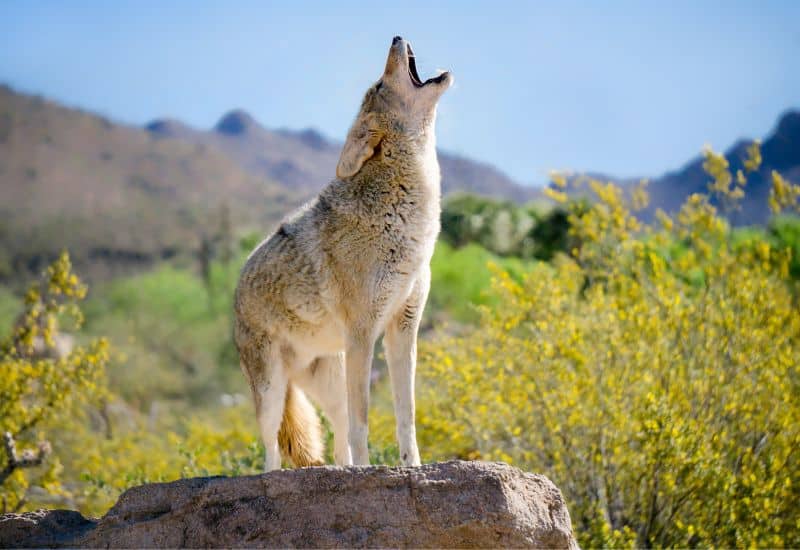
You might spot these elusive creatures in various areas of the Grand Canyon. The Pima Point and the areas around the Desert View Watchtower are often good places to observe them, especially in the quieter hours of the morning or evening.
Coyotes are versatile in their habitat choices and can be seen roaming the scrublands and along the canyon’s rim. Hikers on the Hermit’s Rest Route or near the Yavapai Geology Museum might get a glimpse of coyotes on the move, either solo or in small groups.
Their presence is a crucial part of the Grand Canyon’s ecosystem, as they play a significant role in controlling rodent populations and cleaning up carrion. Observing their behavior offers a unique window into the complex food web of this diverse environment.
As with all wildlife encounters in the Grand Canyon, it’s important to maintain a respectful distance from coyotes. This not only ensures your safety but also protects the natural behavior and habitat of these fascinating animals.
California Condor
The California Condor, renowned for its majestic 10-foot wingspan, is a spectacle as it soars over the Grand Canyon. These birds, the largest in North America, can be best viewed from the South Rim, where they glide gracefully on thermal currents.
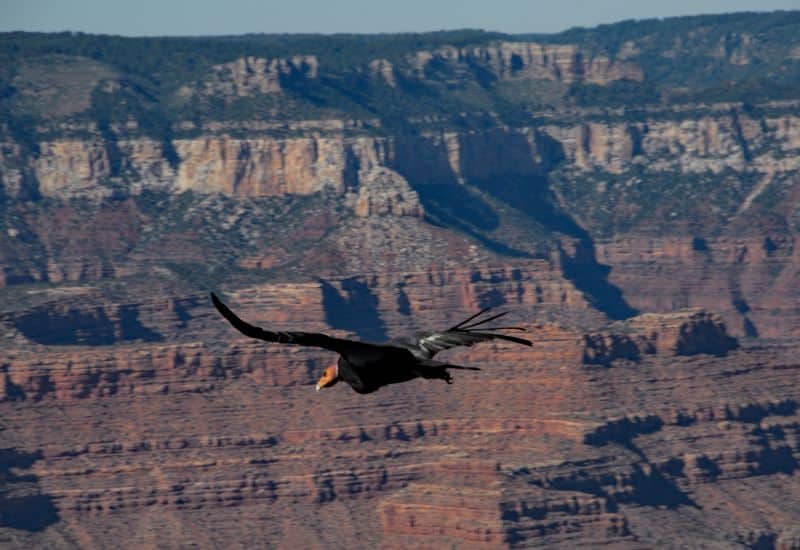
Key spots like the Navajo Bridge and Yavapai Point offer prime viewing opportunities.
Their presence is a testament to successful conservation efforts, as they were once near extinction. Now, they symbolize resilience and the triumph of environmental stewardship.
For those seeking to witness these impressive birds, the areas around Hermits Rest and the Rim Trail are also favorable. Their high-altitude flight, best observed through binoculars or telescopes, provides an unforgettable experience.
Remember, respectful and distant observation is crucial for the protection of these magnificent birds, ensuring they continue to thrive in their natural habitat.
Mountain Lion
The Mountain Lion, elusive and majestic, is a rare but thrilling sight in the Grand Canyon. These solitary predators are known to prowl both the rim and the inner canyon, their presence a reminder of the wildness that still reigns in this vast natural landscape.
Spotting a Mountain Lion requires luck and timing, as they are most active during dawn and dusk. The areas near the North Rim and along the Tonto Trail are known habitats where these big cats may occasionally be seen.
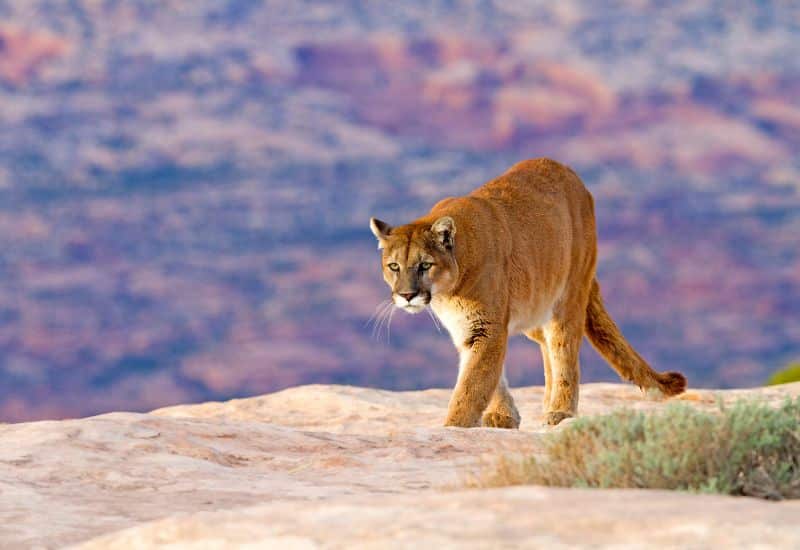
Their stealthy nature makes them challenging to spot, but signs of their presence, like tracks or scat, can sometimes be found along less-traveled paths and in remote sections of the park.
The Mountain Lion plays a crucial role in the canyon’s ecosystem as an apex predator, helping maintain the balance of animal populations. Their presence is a sign of a healthy, functioning wilderness.
Visitors hoping to catch a glimpse of a Mountain Lion should remember to keep a safe distance and never approach or feed wildlife. This ensures both your safety and the well-being of these magnificent creatures.
Ringtails
The Ringtail, often mistaken for a raccoon due to its long striped tail, is a nocturnal creature that adds an element of mystery to the Grand Canyon’s nightscape. These animals are more likely to be spotted during night hikes when they are most active.
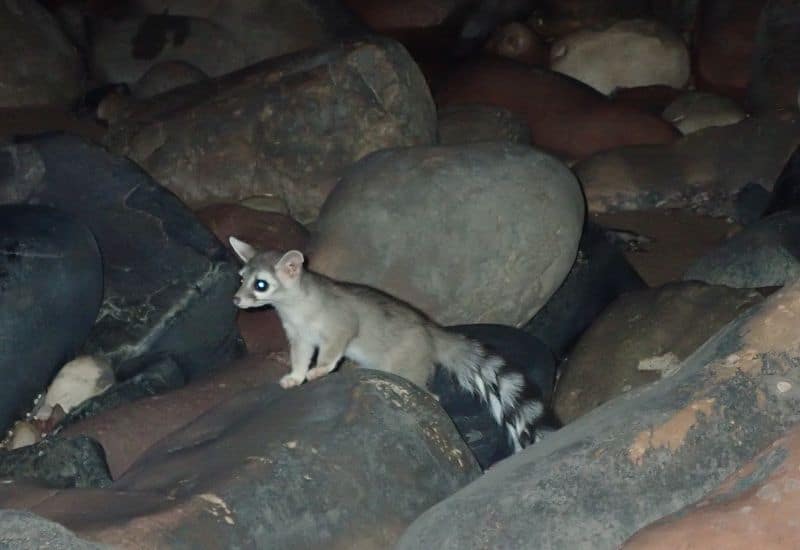
Ringtails are adept climbers and can often be seen scampering along the rocky ledges and in the wooded areas of the canyon. Prime spots for potential sightings include the areas around Indian Garden and along the Bright Angel Trail, where their agile movements in the moonlight can be a delightful surprise.
Their distinctive tails, which aid in balance and agility, make them easily recognizable. Observers may also hear the soft rustling of leaves or small stones, a hint to the presence of these shy animals.
Despite their elusive nature, Ringtails play a vital role in the Grand Canyon ecosystem as small omnivores. They contribute to seed dispersal and help control insect populations.
For those interested in spotting Ringtails, patience and a keen eye are essential. Remember to carry a flashlight and to stay on designated trails for safety during night hikes.
Grand Canyon Rattlesnake
The Grand Canyon Rattlesnake is a creature commanding respect and caution in the park. Recognized by their distinctive warning rattle, these snakes are a vital part of the canyon’s ecosystem but should be observed from a safe distance due to their potent venom.
These rattlesnakes are often found in warmer, drier areas of the Grand Canyon. Key locations for potential sightings include sunlit rocky outcrops and along the South Kaibab Trail. Their camouflage coloring blends with the natural environment, making them hard to spot.
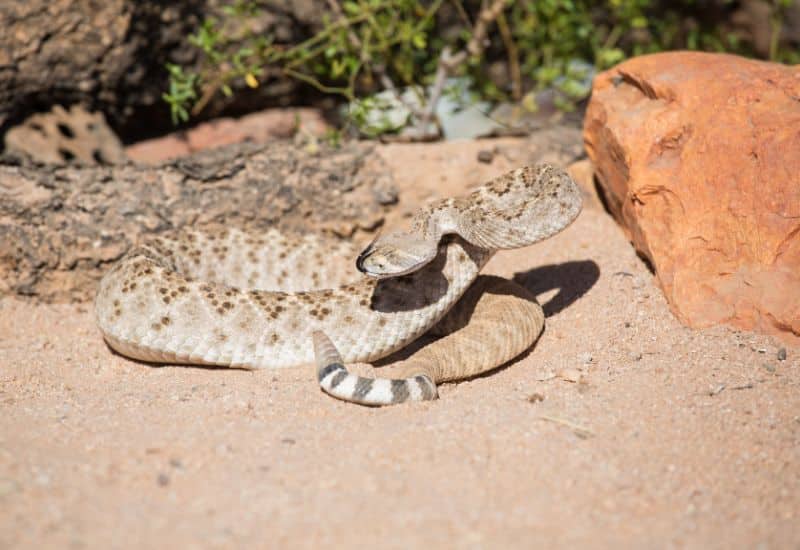
The sound of their rattle is a clear signal to stay back. It’s their way of warning intruders of their presence, a natural defense mechanism to avoid confrontation.
As with all wildlife in the Grand Canyon, it’s essential to give rattlesnakes space. Stepping off trails or reaching into unseen areas increases the risk of an unwanted encounter.
Visitors should be mindful of where they walk and place their hands, especially when hiking in areas known for rattlesnake activity. Respecting these creatures’ space ensures a safe experience for both hikers and the snakes.
Elk
Elk are one of the most impressive mammals you might encounter in the Grand Canyon. Known for their large size and striking antlers, these animals are often seen grazing in open meadows, offering a majestic sight for visitors.
Elk are commonly found in the park’s more open areas, where they have access to grassy meadows for grazing. The North Rim meadows and areas around the South Rim Village are particularly good places to spot these magnificent creatures, especially during the early morning or late evening hours.
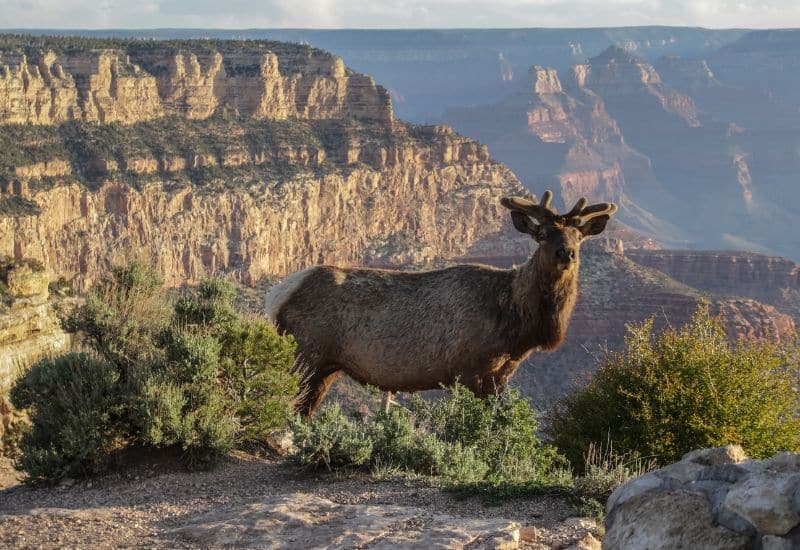
Their antlers, particularly prominent in males, are not just a visual marvel but also play a vital role in their natural behavior, especially during the mating season. The sight of elk with their full antler spread is an unforgettable experience.
As with all wildlife in the Grand Canyon, it’s important to observe elk from a distance. Approaching them too closely can be dangerous, especially during the fall mating season when males can be more aggressive.
For those hoping to photograph or simply observe these majestic animals, patience and a good pair of binoculars can enhance the experience, allowing for a closer look without disturbing their natural behavior.
Collared Peccary
The Collared Peccary, also known as the javelina, is a unique and intriguing species found in the Grand Canyon. These wild pigs are typically seen roaming in groups, foraging for food, and are a fascinating sight for visitors.
Javelinas are most commonly observed in areas with abundant food sources, such as the scrubby woodlands and along the trails of the South Rim. They are especially active during the cooler parts of the day, either early morning or late afternoon.
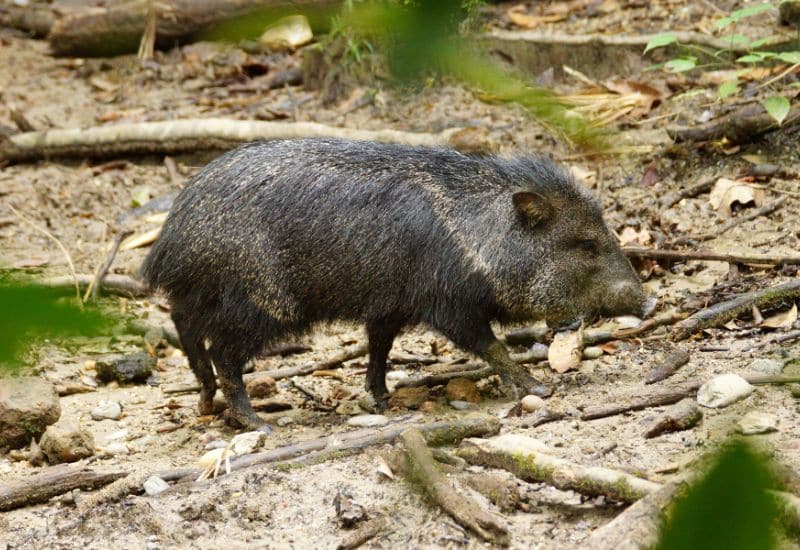
Despite their pig-like appearance, Collared Peccaries are distinct in their habits and social structures. They are known for their strong group bonds and can often be seen moving together in search of food.
While observing these animals, it’s important to maintain a safe distance. Javelinas can be unpredictable, especially when they feel threatened or when protecting their young.
Visitors interested in seeing Collared Peccaries should keep an eye out for signs of their foraging, such as upturned soil or disturbed underbrush, and listen for the rustling sounds of their movement through the vegetation.
Desert Spiny Lizard
The Desert Spiny Lizard is a remarkable reptile commonly found in the Grand Canyon. These large lizards are easily recognizable by the distinctive rows of spines down their brown backs, which help in thermoregulation and protection.
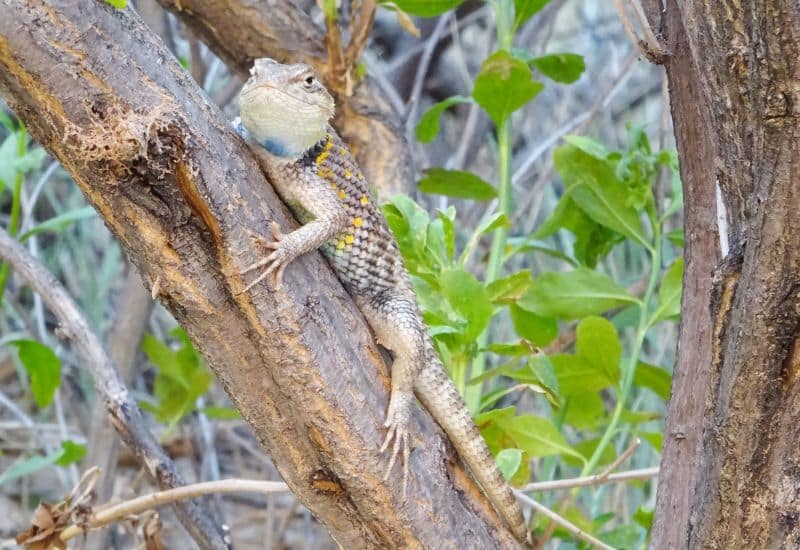
They are most active in warmer months, frequently seen sunning themselves on rocks to regulate their body temperature.
One of the best places to spot these lizards is along the Bright Angel Trail and in the open, rocky areas around the South Rim. Their preference for sun-exposed locales makes them a common sight for hikers and nature enthusiasts.
Observers can look for them basking on boulders or scuttling across warm surfaces, especially during the morning when they are most active.
Observing the Desert Spiny Lizard offers a glimpse into the adaptability of wildlife in arid environments, showcasing how these creatures have evolved to thrive in the challenging conditions of the Grand Canyon.
Red-spotted Toad
The Red-spotted Toad is a colorful and intriguing amphibian found in the Grand Canyon, especially active after rainfall. These toads are known for their vibrant red spots and preference for moist environments.
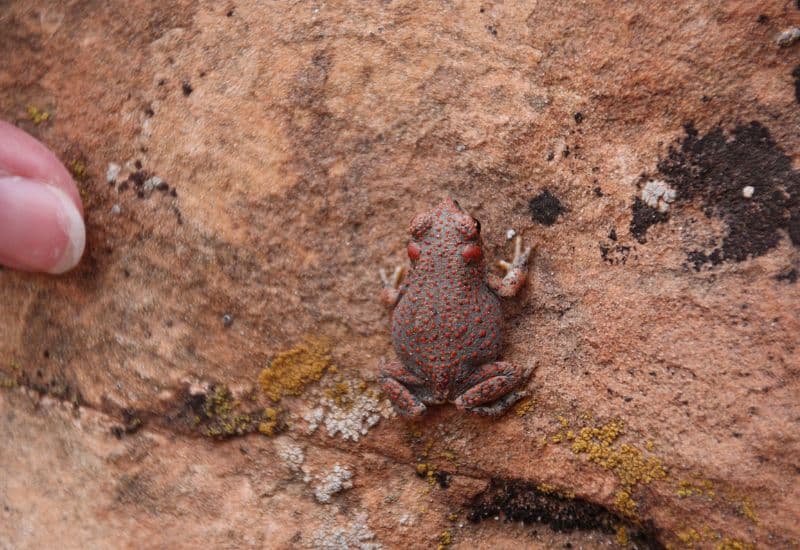
They typically emerge in the evenings, hopping near pools and wet areas, making post-rain hikes an ideal time to spot them.
Areas near Indian Garden and along the North Kaibab Trail are prime spots for observing these toads. After summer rains, when temporary pools and moist habitats form, Red-spotted Toads become more visible as they come out to forage and mate.
Their nocturnal habits and colorful appearance make the Red-spotted Toad a fascinating subject for wildlife enthusiasts. Observing these toads is a reminder of the diverse and dynamic ecosystem of the Grand Canyon, where even small creatures play significant roles.
Golden Eagle
The Golden Eagle is a majestic bird of prey that graces the skies of the Grand Canyon. Known for their impressive size and powerful flight, these eagles are often seen soaring high above the canyon, using thermal updrafts to glide effortlessly.
They nest and hunt along the steep cliffs of the canyon, making the most of the rugged terrain.
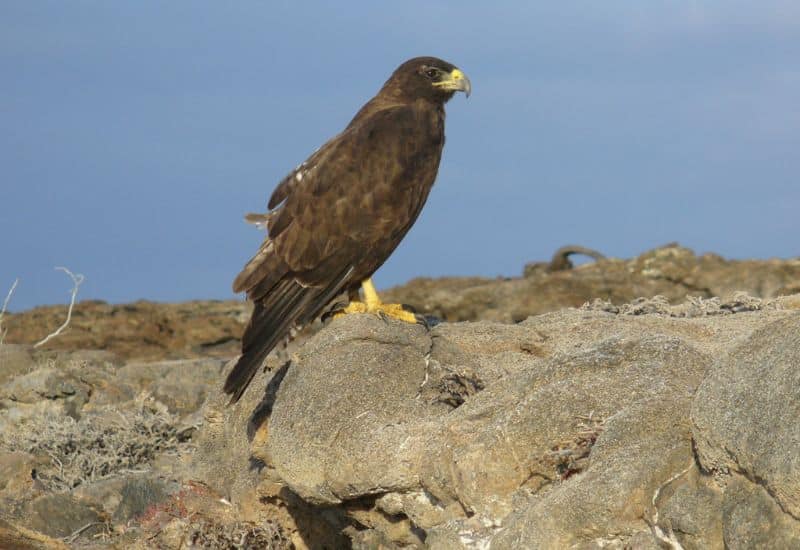
To catch a glimpse of these magnificent birds, look towards the skies over areas like the East Rim and around Zuni Point. The wide-open spaces and high vantage points in these areas offer ideal conditions for the Golden Eagles to hunt and soar.
Early mornings are particularly good times to see them in action, as they set out in search of prey.
Spotting a Golden Eagle in flight is a remarkable experience, a reminder of the grandeur and wildness of the Grand Canyon. These birds embody the spirit of freedom and strength, making them a symbol of the natural beauty of this iconic American landscape.
American Dipper
The American Dipper is a small yet fascinating bird found along the streams and rivers of the Grand Canyon. Unique for their aquatic lifestyle, these birds are known for their characteristic ‘dipping’ behavior, bobbing up and down at the water’s edge and even diving underwater in search of food.
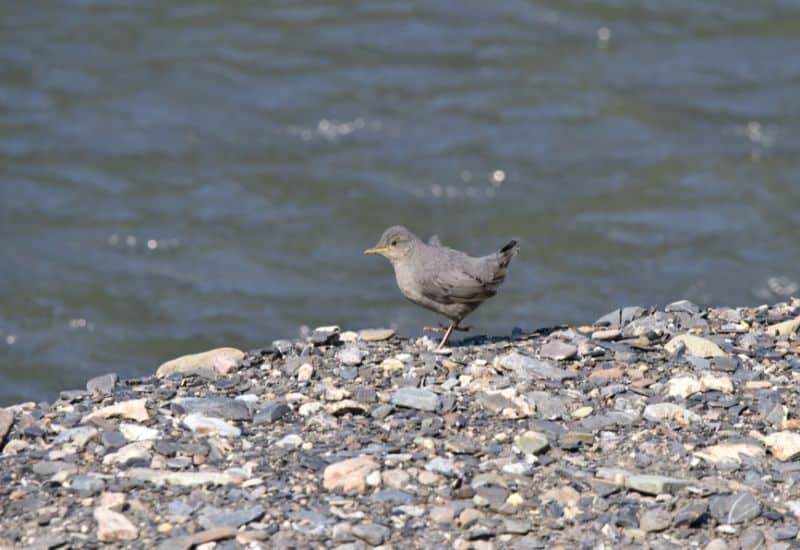
To hear the melodious songs of the American Dipper, visit streamside trails like those along Bright Angel Creek or near the Phantom Ranch. These areas, where streams flow steadily, provide the perfect habitat for these birds.
Their songs, often a series of high, clear notes, add a musical backdrop to the sound of flowing water.
Observing the American Dipper provides a closer look at the diverse birdlife of the Grand Canyon. Their unique adaptation to a semi-aquatic life and their lively presence along the canyon’s waterways make them a delightful sight for birdwatchers and nature lovers.
Western Tanager
The Western Tanager is a striking bird species found within the forests of the Grand Canyon. The males are particularly eye-catching with their bright red heads, vibrant yellow bodies, and black wings.
These songbirds stand out against the green foliage, making them a delightful sight for bird enthusiasts.
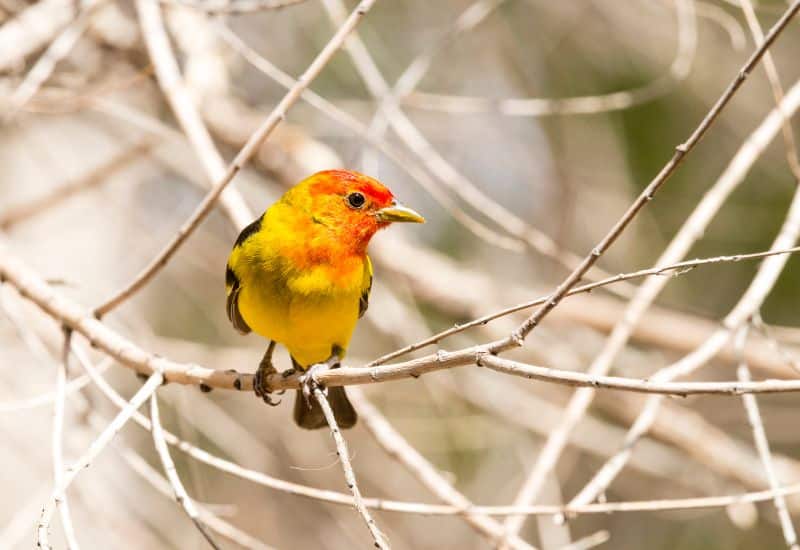
For the best chances of spotting a Western Tanager, explore the forested areas along the North Rim or near Cape Royal. These birds are often more visible in the spring and early summer when they are most active in mating and nesting.
Their presence in the dense canopy can often be detected by their melodious and warbling song.
Observing the Western Tanager offers a colorful glimpse into the avian diversity of the Grand Canyon. Their bright plumage and cheerful songs add a lively and vibrant touch to the natural beauty of the park’s forested regions.
Tarantula Hawk
The Tarantula Hawk is a fascinating and somewhat intimidating insect native to the Grand Canyon. These large, blue-black wasps are known for hunting tarantulas, which they use as a food source for their larvae.
The males, notable for their blue sheen, are often seen on the hunt along various trails in the park.
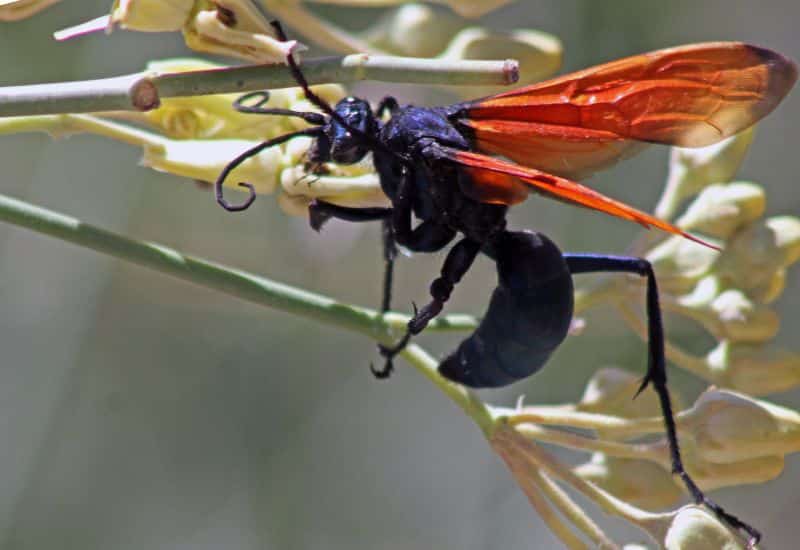
To witness these impressive insects, keep an eye out on open trails, especially in areas like the South Rim or along the Bright Angel Trail. They are most active during the warmer months, particularly in the late spring and summer.
While the Tarantula Hawk’s behavior might sound daunting, they are generally non-aggressive towards humans unless provoked.
Their presence in the ecosystem is a fascinating example of the complex and dynamic food web of the Grand Canyon.
Gila Monster
The Gila Monster is a rare and fascinating reptile found in the Grand Canyon, known for being one of the few venomous lizards in North America. Characterized by their striking patterns of black and pink or orange, these colors serve as a warning of their toxicity.
Gila Monsters are most often found in the more arid and rocky regions of the canyon.
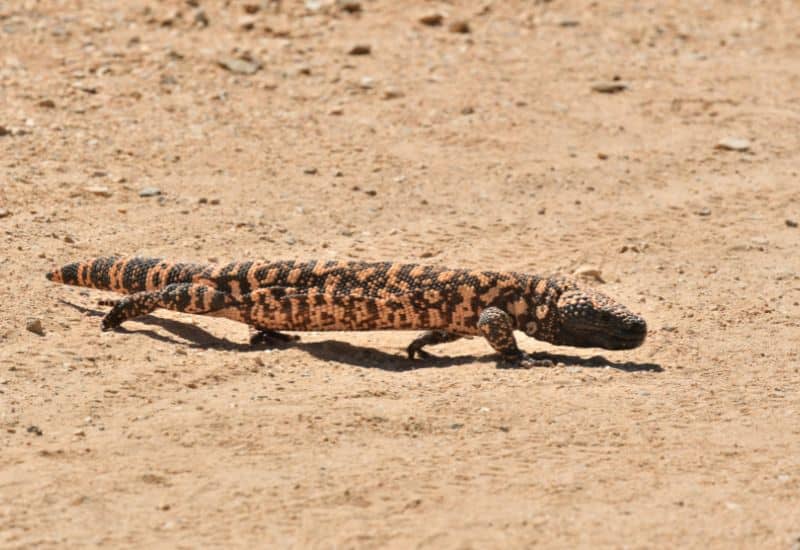
For those hoping to spot a Gila Monster, the areas around the South Rim, especially in the more desert-like habitats, are potential spots. They are usually active during the morning and late afternoon in the warmer months. However, sightings are quite rare due to their elusive nature and tendency to avoid human contact.
Observing a Gila Monster in its natural habitat is a unique and memorable experience, offering a glimpse into the diverse and sometimes hidden life of the Grand Canyon’s reptilian inhabitants.
Peregrine Falcon
The Peregrine Falcon, known as the fastest bird in the world, is a symbol of wild resilience and a spectacular sight in the Grand Canyon. These birds are admired for their incredible high-speed dives, reaching speeds of over 200 mph as they hunt for prey.
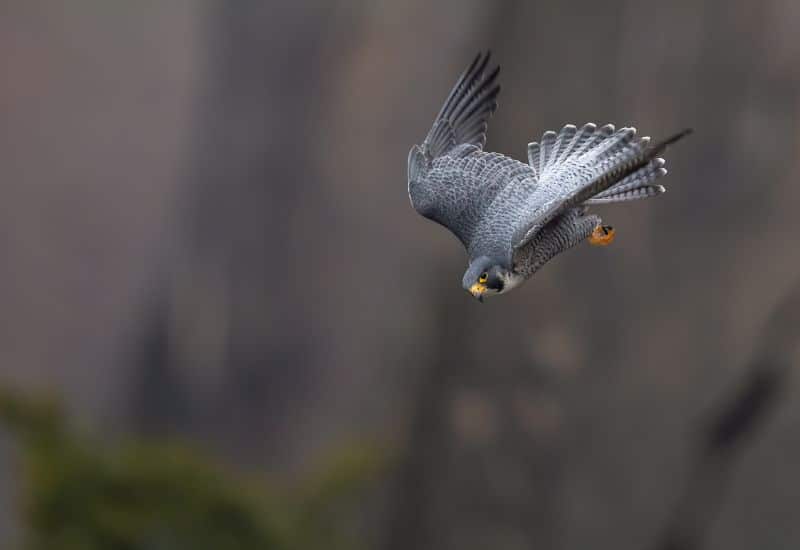
Peregrine Falcons can be seen throughout the Grand Canyon, but they are particularly prevalent along the canyon cliffs where they nest.
To observe these magnificent birds, look towards the open skies or the cliff faces along the North Rim or near Point Imperial. Early morning is often a good time to catch them in action as they hunt.
The sight of a Peregrine Falcon in flight is truly awe-inspiring, showcasing the raw power and agility of these avian predators. Their presence in the Grand Canyon is a testament to the area’s rich biodiversity and the ongoing efforts to protect and preserve these magnificent birds.
Rock Squirrel
The Rock Squirrel is a common sight in the Grand Canyon, known for its curiosity and playful nature. These squirrels are often seen near hiking trails, where they scamper across rocks and logs, providing an entertaining display for visitors.
They are easily recognizable by their bushy tails and gray-brown fur.
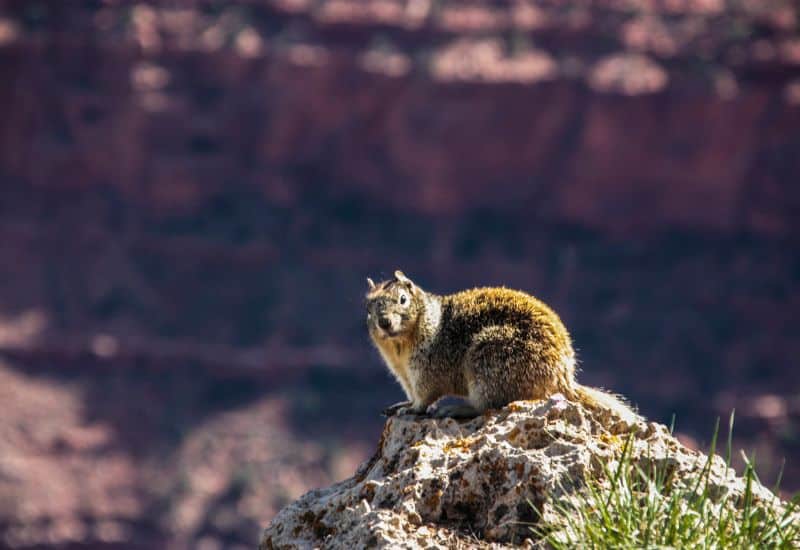
Areas like the South Rim and along the Bright Angel Trail are great spots to observe these energetic creatures. Rock Squirrels are most active during the cooler hours of the day, often foraging for food or basking in the sun.
While observing Rock Squirrels, it’s important for visitors to remember not to feed them, as human food can be harmful to their health and can lead to aggressive behavior.
Desert Millipede
The Desert Millipede is an intriguing insect found in the Grand Canyon, known for its unique defense mechanism. When disturbed, these millipedes curl into tight spirals and can emit a stinging spray as a form of protection.
They are typically dark in color, with numerous segments and legs, making them a fascinating subject for those interested in the smaller inhabitants of the park.
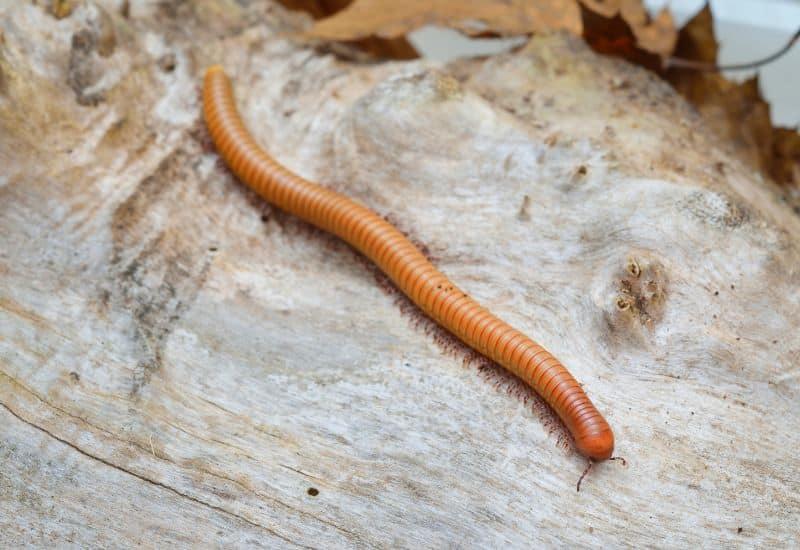
To spot a Desert Millipede, look in areas with underbrush or leaf litter, especially along the North Rim or in shaded areas along the canyon floor. They are more active during the cooler and moister parts of the day.
As with all wildlife in the Grand Canyon, it’s important to observe Desert Millipedes from a distance and avoid handling them, as their defense mechanism can cause irritation to human skin.
Mule Deer
The Mule Deer is a graceful and commonly sighted mammal in the Grand Canyon. These deer are easily identified by their large ears, similar to those of a mule, and their distinctive gait, often described as a bounding leap. They are typically seen in the wooded areas and along the meadows of the canyon, grazing or moving through the underbrush.
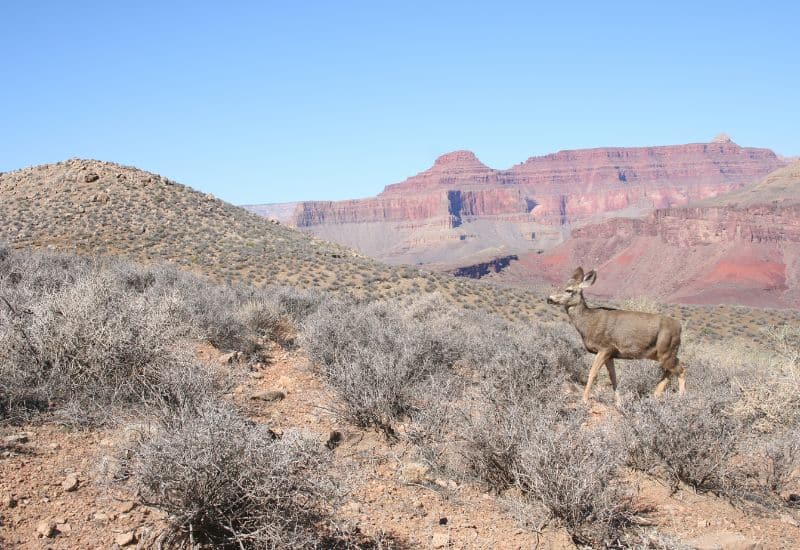
One of the best places to observe Mule Deer is along the North Rim, where they are frequently seen in the early morning or late evening, especially in meadows and near water sources. The Kaibab Plateau and areas around the Bright Angel Point also offer good opportunities for sightings.
Mule Deer play an important role in the canyon’s ecosystem as browsers, feeding on a variety of vegetation, which helps to maintain the balance within their habitat. During the fall, visitors might also witness the rut, or mating season, when male deer, or bucks, are more active and visible.
Visitors are reminded to view Mule Deer from a distance, as approaching wildlife can disturb their natural behavior and habitat. Using binoculars or a camera with a zoom lens can enhance the viewing experience while maintaining a respectful distance.
10 unique tips for wildlife viewing in the Grand Canyon National Park
- Early Morning and Late Evening Viewing: Many animals in the Grand Canyon are most active during dawn and dusk. Plan your wildlife viewing during these times for better chances of sightings, especially for mammals like Mule Deer and Elk.
- Quiet Observation: Wildlife is easily startled by noise. Move quietly and speak softly when you’re near animals to increase your chances of observing their natural behavior without disturbing them.
- Bring Binoculars or a Zoom Lens: To safely observe wildlife from a distance, equip yourself with a good pair of binoculars or a camera with a zoom lens. This is particularly useful for viewing birds like the California Condor or Peregrine Falcon.
- Stay on Designated Trails: For your safety and to protect wildlife habitats, always stick to marked trails. This helps prevent disturbing animals and their natural environments.
- Look for Signs of Wildlife: In addition to actual sightings, look for tracks, scat, or other signs of animals. This can be particularly exciting in the case of elusive creatures like the Mountain Lion.
- Check Water Sources: Animals often visit water sources, especially during dryer months. Areas near streams or ponds, like those along Bright Angel Creek, can be hotspots for wildlife activity.
- Respect Wildlife Space: Never approach, touch, or feed wildlife. This keeps both you and the animals safe. Feeding animals can harm their health and alter their natural behaviors.
- Use Wildlife Viewing Areas: The Grand Canyon has several designated viewing areas that are known for being wildlife hotspots, such as the South Rim and North Rim. These areas are great starting points for sightings.
- Learn Animal Behaviors: Understanding the behaviors of different species, like the foraging habits of Rock Squirrels or the flight patterns of Golden Eagles, can greatly enhance your viewing experience.
- Seasonal Variations: Be aware of the seasonal changes in wildlife activity. For example, many birds migrate during certain times of the year, and reptiles like the Gila Monster are more visible in warmer months.
Remember, the key to successful wildlife viewing in the Grand Canyon National Park is patience, respect for nature, and preparedness. These tips can help you have a more enjoyable and responsible wildlife-watching experience.
Also Read
The Ultimate 2 Day Grand Canyon Itinerary At The South Rim
22 Essential Tips for Photographing the Grand Canyon: Discover the Best Spots!
Top Predators of the Grand Canyon: A Visitors Guide!
21 Cool winter things to do in Grand Canyon National Park!
17 Stops on an Epic Los Angeles to Grand Canyon National Park Road Trip! (Itinerary Included)
6-Day Ultimate Hiking Trip From Las Vegas! (Grand Canyon and Zion Included)
Conclusion
As our journey through the Grand Canyon National Park comes to a close, we hope you’re leaving with a newfound appreciation for its rich and diverse wildlife.
From the stealthy gait of the mountain lion to the regal flight of the golden eagle, each creature adds a unique thread to the park’s vibrant tapestry of life. Remember, wildlife viewing here is not just about the thrill of the encounter, but also about respecting and preserving these natural wonders.
So, on your next visit, armed with our tips, take a moment to marvel at the intricate balance of nature in this grand landscape. Happy wildlife spotting!
FAQ: Wildlife in the Grand Canyon National Park
Are There Predators In The Grand Canyon?
Indeed, the Grand Canyon is home to several predators, including the elusive mountain lion, the adaptable coyote, the seldom-seen black bear, and the stealthy bobcat. While sightings are rare, it’s important for visitors to stay aware of their surroundings. To reduce the likelihood of encounters, hike in groups, make noise on the trail, and always maintain a respectful distance if you do spot one of these wild inhabitants.
Are There Wolves In The Grand Canyon?
Currently, there are no established wolf populations in the Grand Canyon. Historically, the gray wolf did inhabit this region, but due to various factors, including human activity, they have been extirpated. While wolves are absent, the park does host other predators such as mountain lions and coyotes that contribute to the area’s ecological diversity.
Do Sharks Live In The Grand Canyon?
Sharks are not inhabitants of the Grand Canyon. This iconic landform, carved over millions of years in northern Arizona, is far from any oceanic environments where sharks reside. The Grand Canyon’s unique geology and diverse terrestrial wildlife offer a different but equally fascinating natural experience.
Are There Tarantulas In The Grand Canyon?
Yes, tarantulas are part of the Grand Canyon’s ecosystem. The Grand Canyon black tarantula, in particular, is a species often seen in the park. Although their appearance may be daunting, tarantulas are generally not aggressive towards humans and will bite only if threatened. It’s best to observe these arachnids from a distance and avoid handling them to prevent any harm to either party.
Are There Wild Animals At The BOTTOM Of The Grand Canyon?
The canyon floor is a unique ecosystem teeming with wildlife, including mule deer, various reptiles, and a variety of rodents. These animals have adapted to the extreme conditions of the canyon’s inner layers, surviving in the intense heat and dry environment. When visiting the canyon’s bottom, it’s essential to minimize impact on these habitats by staying on designated trails and observing wildlife from a distance.
What Birds Can I See in the Grand Canyon?
The Grand Canyon is a haven for birdwatchers, with species ranging from the majestic California Condor, boasting one of the largest wingspans in North America, to the vibrant Western Tanager. Other notable birds include the Peregrine Falcon, known for its incredible diving speed, and the playful American Dipper, often seen along the park’s streams.
Is It Common to See Snakes in the Grand Canyon?
Yes, snakes, including the Grand Canyon Rattlesnake, are common in the park. They are often found in warmer, drier areas, sunning themselves on rocks. While sightings are frequent, these snakes typically avoid human contact. Visitors are advised to watch their step and give any snakes they encounter plenty of space.
Can I See Aquatic Animals in the Grand Canyon?
While the Grand Canyon is primarily a desert environment, its rivers and streams do support aquatic life. In the Colorado River and its tributaries, you might find species like the Humpback Chub, a fish native to the Colorado River system. However, the diversity of aquatic animals is limited compared to the park’s terrestrial wildlife.

